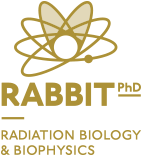Hugo Moreira

PhD Programme: Radiation Biology and Biophysics
h.moreira@campus.fct.unl.pt
Research Areas
PhD Thesis: “Modelling the Effectiveness of Radium 223 in Prostate Cancer" (2014-2018)
Adviser: Prof.ª Doutora Alice Pereira and Prof. Doutor Kevin Prise
Low Linear Energy Transfer (LET) radionuclides have been utilised to allow targeted delivery of radiotherapy to disparate sites of disease, with evidence of palliative benefit. More recently, the bone targeting, high LET radionuclide Radium-223 has been shown to not only have a palliative effect but also a survival prolonging effect in metastatic, castration resistant prostate cancer with bone metastases [1-2]. This has encouraged the use of radium-223 in a more extensive range of setting including earlier in the disease setting and combined with external beam radiotherapy which will form part of a trial (ADDRAD) being led from the Centre for Cancer Research & Cell Biology and the Northern Ireland Cancer Centre. Despite this clinical utility, little is known regarding the mechanisms of action of radium-223 in this setting and accurate assessments of the dosimetry underpinning its effectiveness are lacking. From a radiobiological perspective alpha particles are known to be more effective at killing cells in comparison to low LET radiations such as X-rays with increased relative biological effectiveness of around a factor of 3 in most models. Alpha-particle irradiated cells also show a reduced a dependency on radioresistance mechanisms observed in the absence of oxygen with Oxygen Enhancement Ratios (OER) close to 1.0. As well as direct effects it is also thought that alpha-emitters are capable of producing effects in non-irradiated bystander cells [3]. There is a pressing need to model and quantify alpha-emitter effects in pre-clinical models so the next generation of trials utilising radium-223 can be optimally designed.
Our aim is to develop new biophysical models of radium-223 interaction in bone metastatic models.
We will achieve this by:
1. Performing defined experimental studies in prostate bone cell models using alpha-particle exposure as a model for radium-223 to quantify DNA damage and repair, survival
2. Utilising Monte-Carlo modelling studies mimicking dose-levels given clinically to simulate relevant dose-distributions in 2D and 3D



